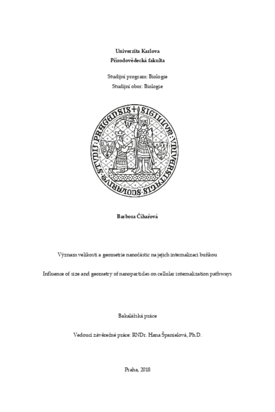Význam velikosti a geometrie nanočástic na jejich internalizaci buňkou
Influence of size and geometry of nanoparticles on cellular internalization pathways
bachelor thesis (DEFENDED)

View/
Permanent link
http://hdl.handle.net/20.500.11956/98530Identifiers
Study Information System: 183979
Collections
- Kvalifikační práce [20091]
Author
Advisor
Referee
Lišková, Petra
Faculty / Institute
Faculty of Science
Discipline
Biology
Department
Department of Genetics and Microbiology
Date of defense
5. 6. 2018
Publisher
Univerzita Karlova, Přírodovědecká fakultaLanguage
Czech
Grade
Very good
Keywords (Czech)
nanočástice, geometrie, internalizace, membrána, virům podobné částiceKeywords (English)
nanoparticle, geometry, internalization, membrane, virus-like particleNanočástice mohou být v biomedicínských oborech využívány jako nosiče pro dopravu diagnostických a terapeutických látek do buněk. Experimentálně se využívají nanočástice různých tvarů, velikostí a různého složení. Navzdory objevům, kterých bylo již v této oblasti dosaženo, přesná povaha interakcí nanočástic s buňkou zatím není zcela pochopena. Cílem práce je poskytnout poznatky o možnostech využití a aspektech ovlivňujících interakci s buněčnou membránou u několika typů modelových nanočástic: u liposomů, u zlatých nanočástic a u viru podobných nanočástic. Ze srovnání vyplývá, že zobecnění buněčného vstupu pro různé typy nanočástic je problematické, ač se zdá, že obecně efektivnější vstup vykazují kulaté nanočástice s průměrem 50 nm.
Nanoparticles can be used in biomedical disciplines as carriers for transport of diagnostic as well as therapeutic substances into cells. Variety of different shapes, sizes and different compositions are used experimentally. Despite the discoveries already made in this area, the exact nature of the interaction between a nanoparticle and a cell has not been fully understood yet. The objective of this thesis is to provide the knowledge about possibilities of utilisation and aspects influencing the interaction between the cell membrane and several types of nanoparticles: liposomes, gold nanoparticles and virus-like nanoparticles. The comparison shows that generalisation of the mechanism of nanoparticle entry into the cell is problematic, although it seems that the spherical nanoparticles with the diameter of 50 nm provide the most efficient entry.
